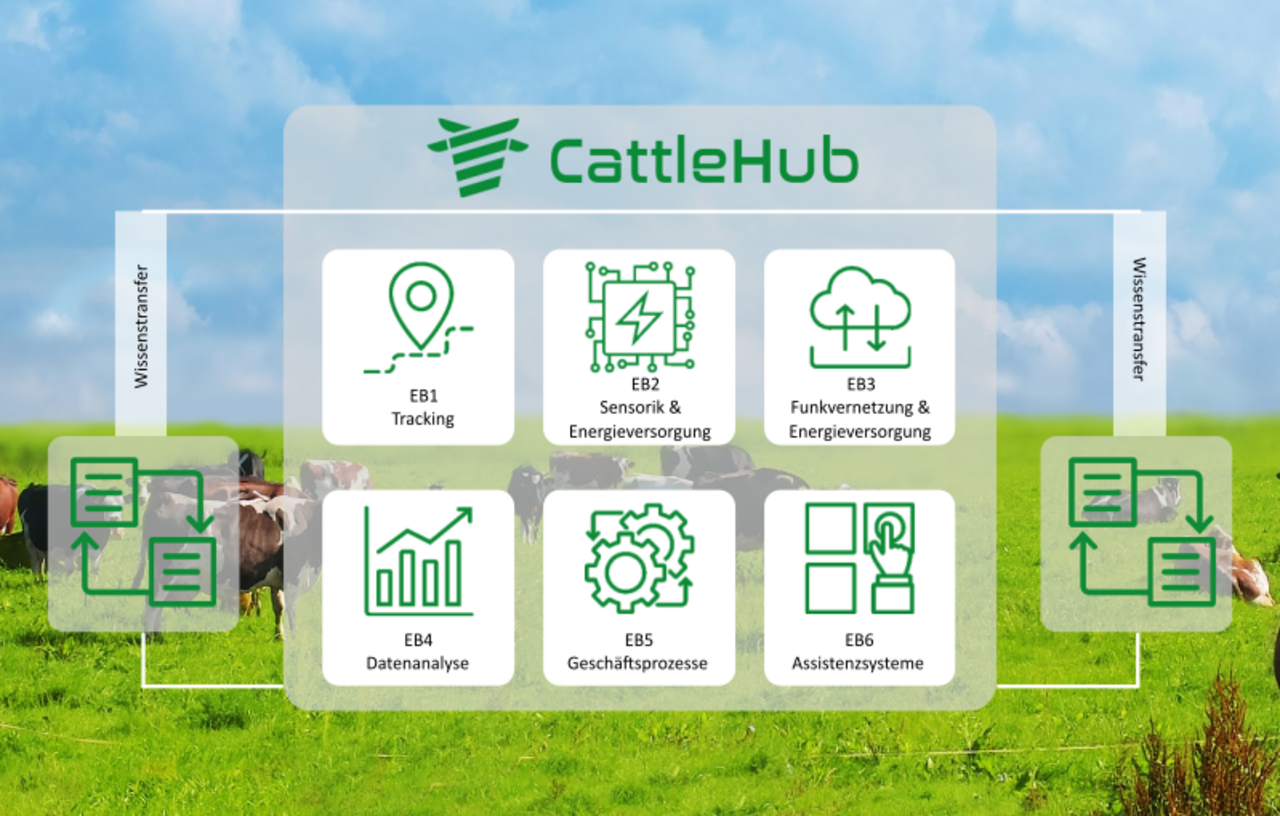Project
Assistance Systems for Smart Cattle Farming

Assistance Systems for Intelligent Cattle Husbandry - "CattleHub"
Digitalisation and automation are increasingly playing a central role in modern cattle husbandry. More and more assistance systems are being offered and especially systems for animal localisation (tracking) in the barn and/or systems for heat detection, health monitoring, etc. are increasingly reaching market maturity. The reliable determination of animal health and behavioural indicators is of great importance for the practical user in decision support.
Background and Objective
Increasing herd sizes in dairy cattle farming place more and more focus on control and animal monitoring tasks, while the workload of livestock farmers is high and there is a shortage of skilled workers at the same time. In future cattle husbandry, the large workload of livestock farmers can be reduced by a high degree of automation, process optimisation and targeted decision support from digital assistance systems. There exist many different systems for decision support, but much data is collected in parallel and still requires manual data linking by the practical user. Digitalisation facilitates a central collection of process-related data and provides livestock farmers with all the information in a unified way for their herd management. Ultimately, this also leads to improved transparency of the processes, more animal welfare and in the long term - hopefully - also to more confidence between producers and consumers.
The collaborative project CattleHub is one of 14 experimental fields of the BMEL to promote digitalisation in agriculture.
As an experimental field, CattleHub deals with assistance systems that will support the livestock farmer even more in his daily work in the future. In order to investigate these specifically, the experimental field is divided into the following six experimental areas, which complement each other in a cluster in an interdisciplinary manner:
- Tracking
- Sensors & Energy Supply
- Networking & Energy Supply
- Data Analysis
- Business Processes
- Assistance Systems
The primary goal of the experimental field CattleHub is to strengthen the establishment of assistance systems in the entire cattle farming sector by transfer of knowledge. Secondary, further developments of subjects in corresponding experimental areas are intended.
Target Group
Practical users, livestock farmers, interested service providers, researchers and consultants
Approach
In each of the above-mentioned experimental areas, practice-oriented use cases of assistance systems are being investigated. In cooperation with the collaborative partners, existing systems are tested, data is collected and evaluated. The experimental area Trackingunder supervision of the Thünen Institute deals with the investigation of relevant use cases based on continuous position measurements and will be validated on experimental and practical farms. These include, for example, lameness detection and monitoring of lying and feeding behaviour of dairy cows. With the help of a reference and selected sensors, existing tracking systems are examined and future use cases based on tracking are tested. For knowledge transfer, events are planned where companies, advisors and livestock farmers will be informed about the status and possible uses of new types of assistance systems in cattle farming. Dairy farms that already use sensors and assistance systems will support the transfer of knowledge into practice. A knowledge database will be set up on the homepage https://cattlehub.de/ so that all interested livestock farmers, service providers, scientists and consultants can get access on information about assistance systems in cattle farming.
Our Research Questions
- How is the reliability and validity of assistance systems in cattle farming?
- How can the interdisciplinary development and establishment of assistance systems be supported in practice for the entire cattle farming sector?
- How can existing assistance systems be examined on the basis of tracking and which use cases can be covered with it in the future?
Thünen-Contact

Involved Thünen-Partners
Involved external Thünen-Partners
- Landwirtschaftskammer Nordrhein-Westfalen
(Bonn, Kleve, Münster, Deutschland) -
Rheinische Friedrich-Wilhelms-Universität Bonn
(Bonn, Deutschland) -
Technische Universität Dresden
(Dresden, Tharandt, Deutschland) - Technische Universität Chemnitz
(Chemnitz, Deutschland) - Sächsisches Landesamt für Umwelt, Landwirtschaft und Geologie (LfULG)
(Nossen, Dresden, Deutschland) -
Friedrich-Schiller-Universität Jena
(Jena, Deutschland)
Funding Body
-
Federal Ministry of Food und Agriculture (BMEL)
(national, öffentlich)
Duration
12.2019 - 11.2024
More Information
Project status:
finished
Publications on the project
- 0
Ahmann J, Höse K, Schmidt A, Thiemann K, Neeland H, Büscher W, Pache S, Umstätter C (2024) Landwirtschaftliche Assistenzsysteme zur Entscheidungsunterstützung in der Nutztierhaltung = Agricultural assistance systems for decision support in livestock farming. agricultural engineering eu 79(2):34-44/34-43, DOI:10.15150/ae.2024.3305
- 1
Umstätter C (2024) Sensoren blind vertrauen? Elite(2):66
- 2
Lamoth M, Neeland H, Umstätter C (2023) Beurteilung von Use Cases zur Tierortung nach dem Grad des Informationsgehalts. Lecture Notes Informatics P-330:399-404
- 3
Sporkmann KH, Neeland H, Engels C, Trilling M, Wegener M, Pache S, Büscher W (2023) Evaluierung eines Funktionsmusters für ein Tracking-Referenzsystem in der Rinderhaltung. Lecture Notes Informatics P-330:513-517
- 4
Stachowicz J, Nasser R, Adrion F, Umstätter C (2022) Can we detect patterns in behavioral time series of cows using cluster analysis? J Dairy Sci 105(12):9971-9981, DOI:10.3168/jds.2022-22140
- 5
Engels C, Wegener M, Neeland H, Wagner M, Büscher W (2022) OpenCattleHub: A portable reference system for indoor tracking in livestock farming. In: Berckmans D, Oczak M, Iwersen M, Wagener K (eds) Precision livestock farming ‘22 : Papers presented at the 10th European Conference on Precision Livestock Farming Vienna, Austria, 29 August - 1 September ’22. pp 602-609
- 6
Ahmann J, Asseburg K, Höse K, Kluth N, Neeland H, Plettemeier D, Wagner M, Büscher W (2021) CattleHub - Assistenzsysteme für eine intelligente Rinderhaltung. Lecture Notes Informatics - Proceedings P-309:355-360
- 7
Sporkmann KH, Neeland H (2021) Wo ist welche Kuh? DLG Mitt(6):58-60

![[Translate to English:] [Translate to English:]](/media/_processed_/3/6/csm_Hintergrund-Ausschnitt1_9daaef6b89.jpeg)
![[Translate to English:] [Translate to English:]](/media/_processed_/3/6/csm_Hintergrund-Ausschnitt1_0bd7111163.jpeg)




